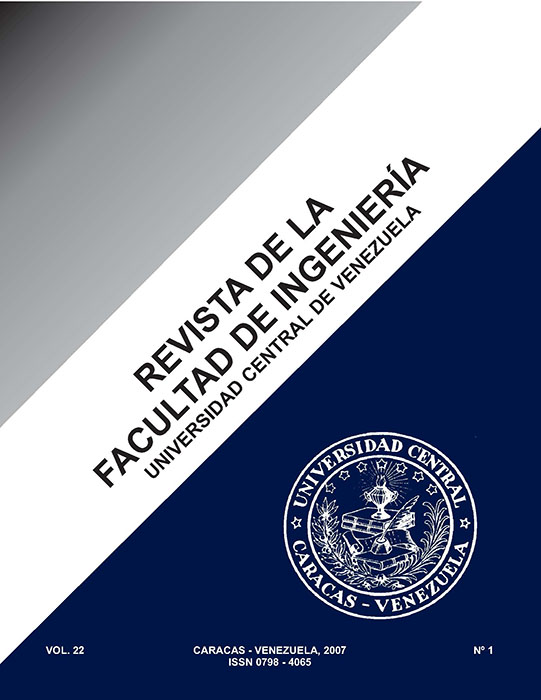PREPARACIÓN Y EVALUACIÓN DE CATALIZADORES MÁSICOS Y SOPORTADOS A BASE DE ÓXIDOS DE VANADIO Y MAGNESIO. DHOX DE n-BUTANO / Preparation and Evaluation of Non Supported and Supported Catalysts Based on Mixtures of Vanadium and Magnesium Oxides for the Odh of
Palabras clave:
Deshidrogenación oxidativa, n-butano, olefinas, butadieno, catalizadores.Resumen
En este trabajo se estudió la Deshidrogenación Oxidativa (DHOX) de n-butano sobre cuatro catalizadores de VMgOsoportado y no soportado, con una relación atómica Mg/V igual a 4. Uno de ellos fue soportado sobre un 30% en peso deSiO2 (S16) y otro sobre un 30% en peso de α-Al2O3 (A16). Ambos fueron calcinados a 600oC. Del catalizador no soportadose prepararon dos muestras: una calcinada a 600oC (B16) y la otra a 700oC (B17). Todos los catalizadores fueron caracterizadosmediante DRX, XPS, TPR, análisis químico por absorción atómica y la medición de la superficie específica (BET). Salvo porel mayor nivel de sinterización y la menor superficie específica, se encontró que el catalizador B17 no presenta diferenciassignificativas con el B16. Para las pruebas experimentales se utilizó un reactor tubular de cuarzo al que los reactantes sealimentaron con una composición de C4H10/O2/N2 = 8/12/80, la temperatura de reacción se varió en un rango de 480 a 550ºC,y los tiempos de contacto utilizados fueron 6, 25 y 50 gcat min/moltot. La variante introducida en el método de preparacióndemostró ser efectiva para asegurar la reproducibilidad en la preparación. Con el catalizador B17 el control del reactor, bajocondiciones aeróbicas, resultó ser muy difícil y en consecuencia se trabajó con los catalizadores calcinados a 600oC. Seencontró que el uso de un tercer óxido, como el SiO2 o la -Al2O3, desmejora la actividad y la selectividad de la fase activa,pero que las variaciones son leves: del orden del 5% al 8 % en la selectividad a butadieno y del 3 al 5 % en la actividad. Losresultados obtenidos muestran una consistente mejora en el comportamiento de los catalizadores cuando se los comparacon los obtenidos por otros autores, lo cual se explica por las mejoras introducidas en el método de preparación. Elcatalizador soportado sobre α-Al2O3 (A16) presentó mejor actividad (31% de conversión) y selectividad integrada (total)hacia hidrocarburos no saturados (80%) que el soportado sobre SiO2, el cual mostró una conversión del 29% con unaselectividad total del 77%.
ABSTRACT
In this work the Oxidative Dehydrogenation (ODH) of n-butane has been studied over four supported and non-supportedVMgO catalysts with an atomic Mg/V ratio of 4. One of them was supported over 30% by weight of SiO2 (S16) and anotheron 30% of -Al2O3 (A16), both being calcined at 600oC. Two samples of the non-supported catalyst were prepared, onecalcined at 600oC (B16) and the other at 700oC (B17). All catalysts were characterized by DRX, XPS, TPR, chemical analysisby atomic absorption, and by the specific surface (BET). With the exception of the sintering level and the lower specificsurface area, the catalyst B17 gave results similar to those obtained with the B16. Experimental runs were done in a quartztubular reactor with an inlet composition for reactants of C4H10/O2/N2 = 8/12/80, the reaction temperature was varied from480 to 550 ºC and contact times of 6, 25 y 50 gcat min/moltot. were used. The change introduced in the catalysts preparationmethod has demonstrated to be effective in assuring the reproducibility in their synthesis. The reaction conditions for thecatalyst B17 proved to be quite difficult to control and for this reason was not used. It was found that the addition of a thirdoxide, such as SiO2 or -Al2O3, reduces the catalytic activity and selectivity of the active phase, but this variations are small:from 5 to 8 % in selectivity toward butadiene and from 3 to 5% for the activity. The experimental results showed a consistent improvement in the catalyst’s behavior when it is compared with similar catalysts prepared by other researchers, which isexplained by the improvement introduced in the preparation method. The catalyst A16 showed a higher activity (31% ofconversion) and a higher overall selectivity (total) toward unsaturated hydrocarbons (80%) than the supported over SiO2(S16), which showed a conversion of 29% with a total selectivity around 77 %.Keywords: Oxidative Dehydrogenation, n-butane, olefins, butadiene, catalysts.



